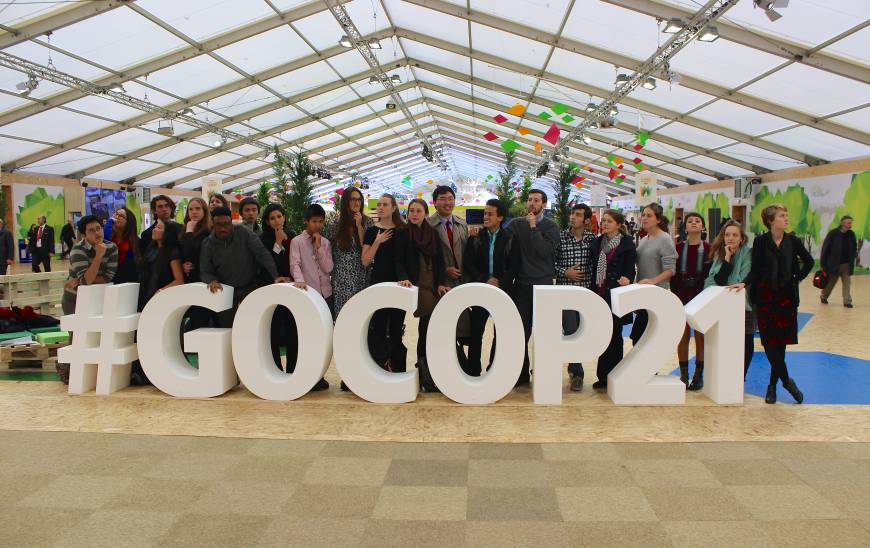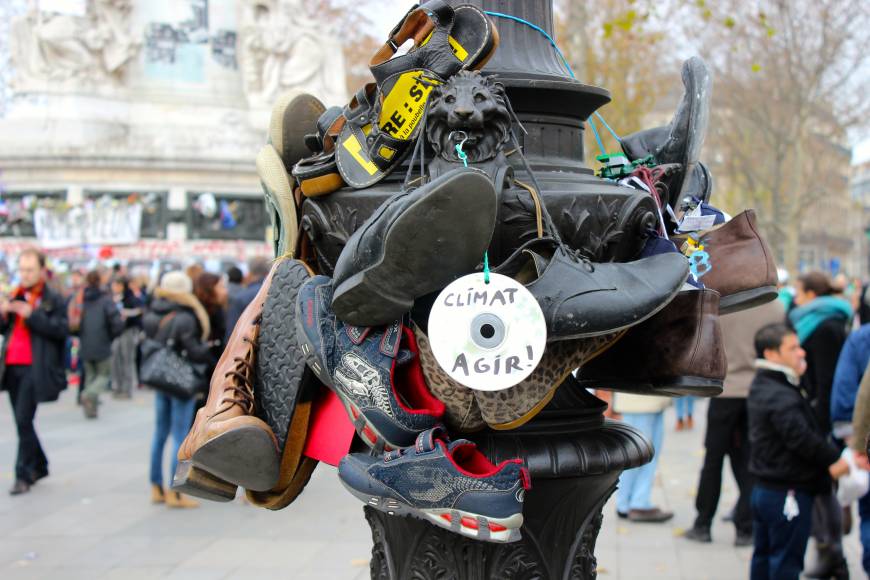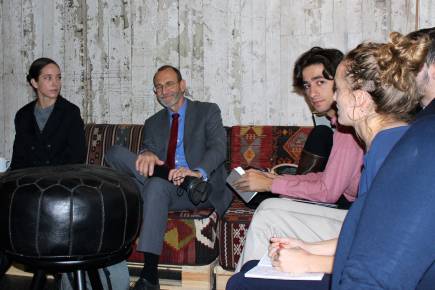Stanford students have front-row seats at Paris climate talks
Thirty Stanford undergraduates traveled to Paris for the historic COP21 international climate change negotiations and came back with stories to share.
By
Ker Than
February 9, 2016

Credit: Richard Nevle
In January, more than two dozen Stanford undergraduates and co-term students from a variety of majors across campus crammed into a conference room to share their insights from a unique trip to a historic climate change meeting that took place in Paris last winter.
The students were part of a Stanford delegation, including several faculty, who traveled to observe the latest negotiations during COP21, the 21st session of the Conference of the Parties (COP) to the United Nations Framework Convention on Climate Change, in December.
“The prospect of taking 30 students to Paris was at times, a daunting one, especially after the November terrorist attacks in the city,” said Sara Cina, the Undergraduate Program Director at Stanford’s School of Earth, Energy & Environmental Sciences.
“We wanted to ensure that everyone would have the freedom and flexibility to pursue their own research agendas while at the same time providing support and structure in the frenzy of the conference,” said Cina, who helped coordinate logistics for the course in Paris.
In preparation for the trip, the students enrolled in a fall quarter course, International Climate Negotiations: Unpacking the Road to Paris, co-taught by Richard Nevle, deputy director of the Earth Systems Program; Aaron Strong, a graduate student in the Emmett Interdisciplinary Program in Environment and Resources (E-IPER); and Earth System Science graduate student Neil Tangri.
The course, offered by the School of Earth, Energy & Environmental Sciences and the School of Engineering, and open to students from all disciplines and levels, covered the basics of climate science and the history of climate negotiations, as well as background on elements of the negotiations such as carbon markets, transparency and emissions accounting, finance for climate adaptation, and the perspectives of indigenous populations.
“The process of studying this over 10 weeks and then going to Paris while all this is happening can be a transformative experience,” Tangri said. “These meetings are full of protests and political theater and civil society meetings. They are places where fundamental issues of justice and visions of what we as a global community want the world we live in to be like are hashed out.”
Paris marked the second time that Stanford students have had a front-row seat at international climate talks. In 2009, Stanford faculty members Terry Root and Stephen Schneider taught a course to prepare students for COP15 and then traveled with the students to the meeting in Copenhagen, where negotiators ultimately failed to come up with a meaningful agreement.
This time around, the students were witness to a meeting that seemed to get more of the world on the same page when it comes to controlling carbon emissions: The Paris climate agreement reaffirmed nations’ long-term goal of keeping global temperature increases below 2 degrees Celsius, sets a more ambitious aspirational target of capping global warming at 1.5 C, and focuses not just on mitigation activities but on adaptation as well.

Credit: Richard Nevle
Josh Lappen, ‘17, came away from the experience cautiously optimistic. “The Paris Agreement is a triumph of diplomacy and a gateway to action. For the first time, the world has agreed to meaningfully confront climate change,” Lappen said. “But these words, partially by design, are no guarantee of action. It is our work over the coming days and years to turn our ambitions into reality by holding our governments accountable. The power of Paris is not that it mandates action, but that it empowers us to mandate that action.”
Even though most of the students were not able to witness the negotiations directly, they were able to meet with scientists, negotiators, journalists, and nonprofit leaders and documented their experiences in online blog posts and photo galleries. “One of the best things about being there in person,” Cina said, “is that the sheer volume and sometime chaotic nature of activity centered around the COP creates space for chance meetings with people that would otherwise be very hard to pin down, such as a head of state or the co-founder of a major nonprofit.”
Each student also pursued meetings and interviews related to individual research questions that interested them. These personal projects covered topics ranging from how the negotiations were handled in the media to the fate of particular interest groups to detailed analyses of the agreement’s language. “We wanted the students to have a specific focus to engage with at the COP,” Nevle said. “The intention was to teach them different aspects of research, and in particular how one goes about conducting research at a meeting like this.”
The students also had the opportunity to brief with some of the Stanford Earth faculty who were directly engaged with different aspects of the talks. Chris Field, co-chair of Working Group II of the the United Nations’ Intergovernmental Panel on Climate Change (IPCC) and the Melvin and Joan Lane Professor for Interdisciplinary Environmental Studies at Stanford, discussed the role of IPCC at the COP.

Chris Field (center) and Katie Mach (left) speak with Stanford students in Paris. Credit: Richard Nevle
Back at Stanford, the students presented their projects–which spanned the gamut from research papers, podcasts, videos, and art projects–at a research symposium in early January.
“The projects took a tremendous amount of preparation,” Strong said. “The final results are stories–some have to do with the negotiations, while others have to do with the people who were there trying to make a difference in the world.”
John Zhao, ‘18, looked at the effects of carbon emissions on economic growth. “I was curious about whether we can grow our economies while still addressing climate change,” Zhao said. “I discovered a movement called ‘Degrowth,’ which advocates for developed countries to contract their economies instead of growing them.”
Madeline Lisaius, ’18, an Earth Systems major, turned her attention to the indigenous people from around the world who congregated in Paris to make their voices heard. “Oftentimes the voices of indigenous people are not included in environmental talks,” Lisaius said. “They’re not actually invited into the U.N. meetings. They have to stay in the civil society space, which means they really have limited access to actually share their message.”
Lisaius said that in her experience, the indigenous people she encountered were more open about the threats of climate change than the official COP negotiators. “Among the indigenous people I interviewed, there was an inherent knowledge that climate change is real and happening and that urgent action was needed,” Lisaius said. “Whereas negotiators often skirted around this by saying that ‘We think climate change is happening’ and ‘We think it’s happening to this extent and we need to be taking relatively urgent action because our Earth is pretty important to us.’ But there was never a definitive statement.”
Tangri said he was delighted by the way the course turned out. “As a teacher, I could not imagine a more rewarding experience,” he said. “We put a lot into this class, and it was very satisfying to see the students take it all in and run with it.”



